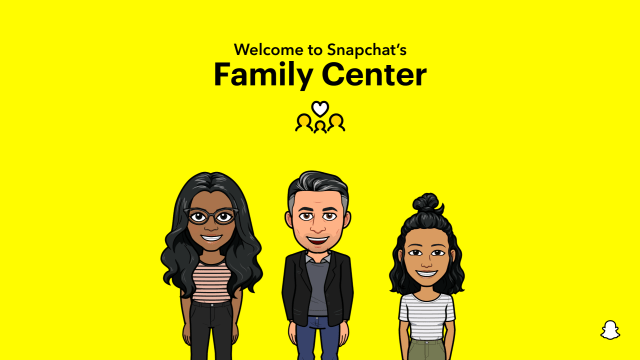Snapchat has introduced its first ever parental controls, under an app section called Family Centre. The company described the new feature in a blogpost on Tuesday. Parents and guardians will now be able to keep tabs on who their teens are friends with and who they’ve chatted with recently (provided the aforementioned teens agree to the monitoring in-app). Notably though, the content of those conversations won’t be visible to parents.
“Family Centre is designed to reflect the way that parents engage with their teens in the real world, where parents usually know who their teens are friends with and when they are hanging out – but don’t eavesdrop on their private conversations,” wrote the company in its blogpost.
One big hurdle: to access the Family Centre, parents and guardians will need to make a Snapchat account and be able to navigate the app. (Probably, many parents will have to ask their teens to help them with the set-up steps.) The monitoring feature will be accessible on the search bar and also at the bottom of the settings menu. And the monitoring + monitored account will need to be bi-directional friends to allow for parental control.
“Parents, guardians, or trusted relatives aged 25+ can invite their family members to join Family Centre,” explained the company in a video introducing the feature. Only Snapchat users between the ages of 13-18 are able to join a parent’s Family Centre. As the company noted in the same video, it’s against Snap’s terms of service for kids younger than 13 to make an account.
Once parents have sent the invite, teens will need to opt-in and accept for their activity and friends list to be viewable by parents. Parents will then be able to see their teens’ complete friend list, who they’ve chatted with in the past seven days, and to report accounts of concern to Snapchat. Again, no conversational content will be viewable through family centre, the company repeatedly emphasised in the feature announcement. And teen users will be able to see a “mirrored view” of what their parents see in Family Centre.
Eventually the Family Centre will include additional features like content controls and a new report function where teens can simultaneously notify the company and their parent(s) when they flag another user or a piece of content, said Snapchat. “Our goal is to help empower parents and teens in a way that still protects a teenager’s autonomy and privacy,” the company wrote.
Snap’s announcement of parental controls was hinted at back in October 2021, but has materialised at a particularly tumultuous time for the company. Even with the rapid rise of TikTok, Snapchat and its disappearing messages have stayed popular among teens. However, the company has faced multiple lawsuits. At least two of those cases are wrongful death suits brought by parents after their children committed suicide.
Although Snapchat has recently billed itself as something of an “anti-Instagram,” meant to foster real-world connection over comparison and viral content, the app’s ephemerality means that it can be a hotbed of things parents hate, like bullying, sexting, and drug dealing.
And social media companies are facing renewed scrutiny for their role in shaping young peoples’ mental health, after a Facebook whistleblower leaked internal company documents revealing the potential scope of harm last year. Since then, a Senate panel has approved two bills called the Children and Teens’ Online Privacy Protection Act and the Kids Online Safety Act which would limit the data that tech companies can collect on minors and allow that data to be more easily deleted.
On top of the pressure to be less damaging to kids, Snapchat has also faced financial difficulty. Apple’s “App Tracking Transparency” feature, introduced in 2021, allowed iPhone users to easily avoid targeted advertising, cutting off a big source of Snap’s cash flow. Recently, the company has sought to open up new revenue streams with the introduction of a paid subscriber tier, and a doubling down on its hardware side. But nevertheless Snap reported its worst quarterly growth ever at the end of July.
Maybe parental controls will help the app rebuild public trust. Or maybe the whole system is a bid to simply get more people making Snapchat accounts and boost future growth.
